Pollinator Feature: Snowberry Clearwing or the Flying Lobster!
Greetings from the homestead! It's pollinator season! The winged ones are all over the homestead and it's a true blessing to watch.
At any hour of the day, I can walk around the land and see multiple species of butterflies, bees of all types and yes less desired ones like stink bugs and Japanese beetles! Another winged one has been catching my eye all season and I went out yesterday to try to capture it with my digital camera.
The butterflies are more gregarious with my camera, but this creature, a "bumble bee mimic" immediately flew away when it saw me coming! I had to court it and wait a bit. I'm pretty good at this type of persistence. Spending a lot of time in nature, part of the fun is the patience of observation. It's especially rewarding when you finally get the shot!
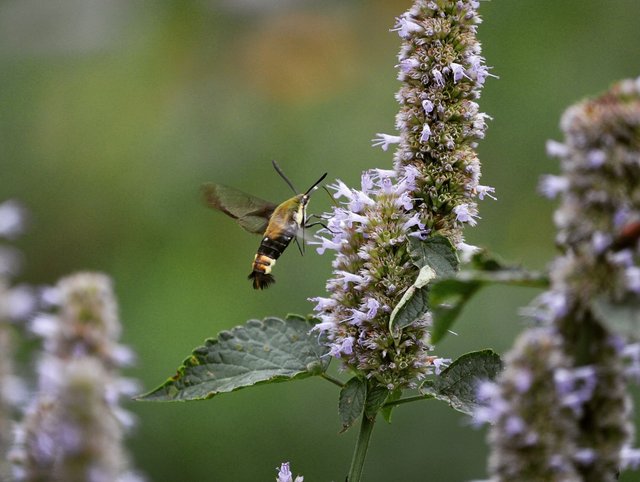
Snowberry Clearwing
What a name! Also known as the Flying Lobster or Hummingbird Moth, these aren't to be confused with the Hawk Moth of Europe. Hemaris diffinis's wings beat at 70 beats per second, making this one a difficult specimen to photograph! This one certainly zipped around the Anise Hyssop only pausing to stick its proboscis into the inviting lavender flowers.
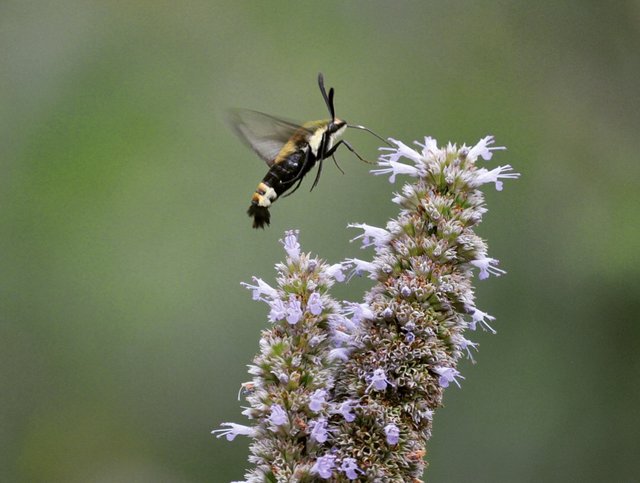
Many gardeners may also carry disdain for a relative of the Snowberry Clearwing, the Sphinx moth. Yes, you guessed it, it is the moth of the hornworm known for devastating tomatoes especially, but targetting many members of the Solanaceae family. No worries, the Flying Lobster's caterpillar wont devastate your tomatoes the way this other "hummingbird moth" will.
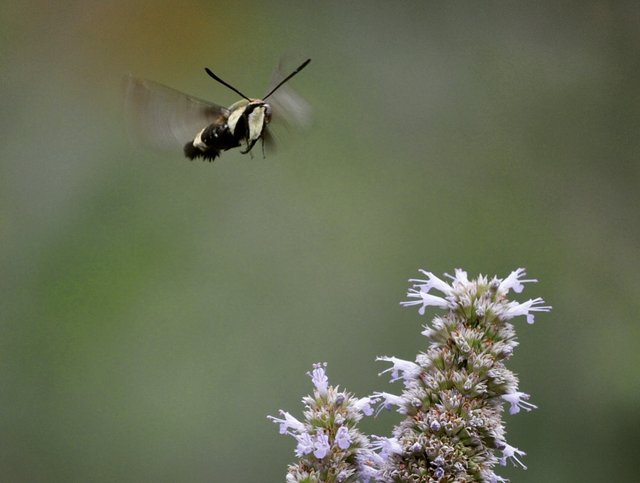
In fact, be happy if you cross the path of this creature! A sighting is rare indeed! You can encourage the presence of these day-time moths by planting habitat that they enjoy. They have loved our Anise Hyssop (part of the mint family) this year. Other plants they enjoy include: Japanese honeysuckle, beebalm, mints, red clover, lilac, phlox, snowberry, cranberry, blueberry, vetch, and thistles.
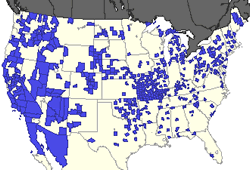 Distribution Map of Hemaris diffinis
Distribution Map of Hemaris diffinisI love to find these creatures and delight even more in the names we've given them. My favorite for this one is the Flying Lobster! The Agastache (Anise or Giant Blue Hyssop) in our garden has been one of the main sites for a diverse host of winged ones. I highly recommend adding this easy-to-grow beautiful and useful (it's anise-flavored leaves are used as an herbal medicine) into your garden.
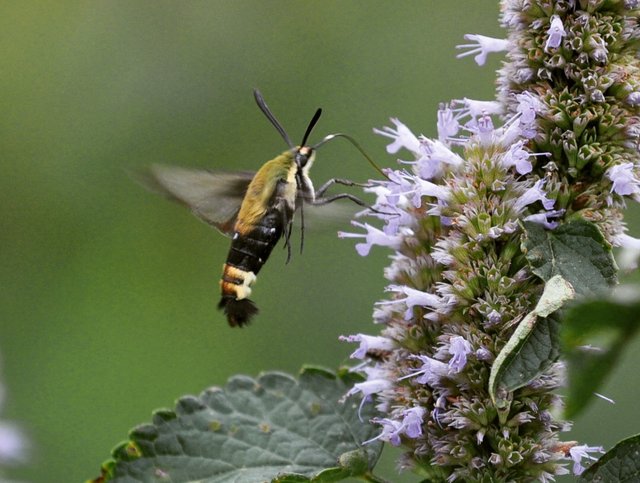
Free & Interesting Pollination Services
More than 70% of the world’s flowering plants rely on pollination which is essential for producing fruits and seeds.
With declining rates of pollinators happening all over our world, using even a small corner of your yard for pollinator habitat is a wise human move.
Many of the plants they delight in, like this hyssop, are easy to grow and delightful perennials. Pollinators are the strings that weave the ecosystem together. They not only pollinate plants which is a complex activity impossible to be easily replicated by humans or machines, they also:
- Help move nutrients through an ecosystem
- Enhance diversity through cross-pollination & increase crop yield
- Include species, like parasitic wasps and ladybugs, which eat garden pests keeping the need for pesticides and sprays down
- Basically are the conduits of plant evolution and resilient life-cycles!
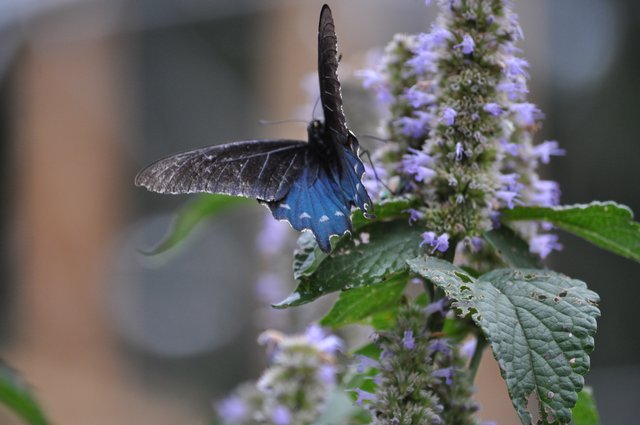
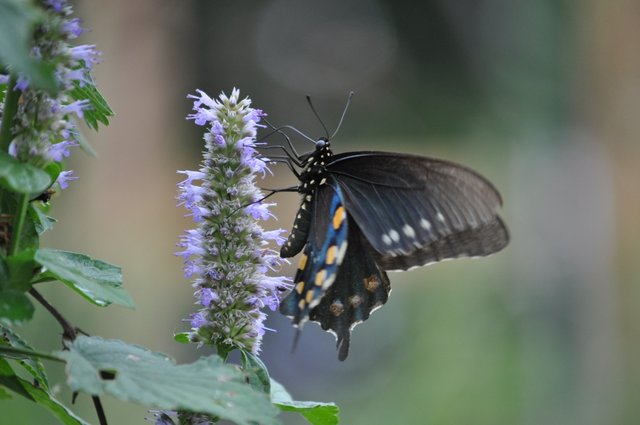
Pipevine Swallowtail also loving the Anise hyssop - I'm telling you, this plant is pure pollinator gold!!
You can easily google a list of pollinator habitat species for your region. It is a beautiful & enjoyable (dare I say ecstatic?) process to interact with the life cycles of pollinators. I get so much out of it, it's a no brainer.
Cut up your lawn and add a section for pollinators today!!
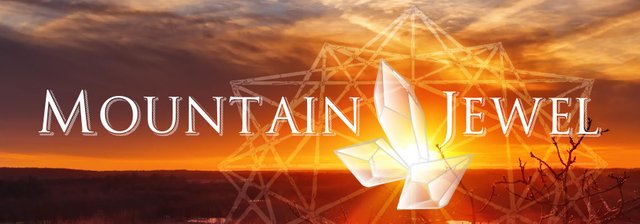


beautiful flowers
thank you! quite beautiful :D
Beautiful pic and me pic up vote and comment for u
thank you very much.
Pretty interesting insect I've never seen one of those and it surely looks like a hummingbird it might even weight more than the smaller types of hummingbirds, what you think?
I'm not sure if it would weigh more! Perhaps the pictures are misleading, but it is much smaller than an a hummingbird. Very neat creature! Thanks!
Alright that makes sense. Great shots! Keep it up.
Beautiful photos. The hummingbird moth is awesome. Reminds me of growing up. We had a cat that would try to catch these moths. Sit under the plant the moth was hovering next to...then spring into the air. He usually missed and ended up doing a somersault. Haha thanks for reminding me of the good memory.
aw cool story! our cat jumps at these and the butterflies (and birds too!)
I’ve seen a few of these guys buzzing around our beebalm (or maybe its the same guy over and over) and thanks to you I now know what it is called 😀
Posted using Partiko iOS
you are welcome! it's fun to put a name on a creature- especially one with such a fun name :) mmm bee balm! a fav of mine as well <3
Love,love,love this!!! I remember they loved our bee balm, that was what originally attracted them to our garden. Such a sweet blessing, your shots are magnificient! ox
awww how sweet! thanks mama! i loved your bee balm plants and am sad i didn't take any!! xo
That's one cool pollinator, with excellent names! I have anise hyssop, and all the others except snowberry, blueberry, and Japanese honeysuckle. If the mosquitoes weren't so bad, I'd spend more time out there looking....
right! such cool names! nice, you have a great collection! luckily the mosquitos aren't too bad this time of year here, but now that I saw that i do realize i've been avoiding certain places at different times in the day to stay away from that inane buzzing and the bites!!
These photos are just the best! I love them and I love how you been patient enough to get them. I can see you moving through the garden like a cat or a tiger waiting to capture your prey in the form of a photograph. Little wonder your hard drive must be full of them. It makes me want to get out my camera and I will do come spring. Well done on the photos and thanks so much for sharing I'm getting so much Delight out of your garden at the moment and looking disc constantly at mine saying hurry up spring your bastard.
holy of holies....those images ya'll!!!!!!!!!!!!!!!!!!!!! :)
This is the first year we've noticed hummingbird moths hanging around our place. Always glad to have more pollinators!